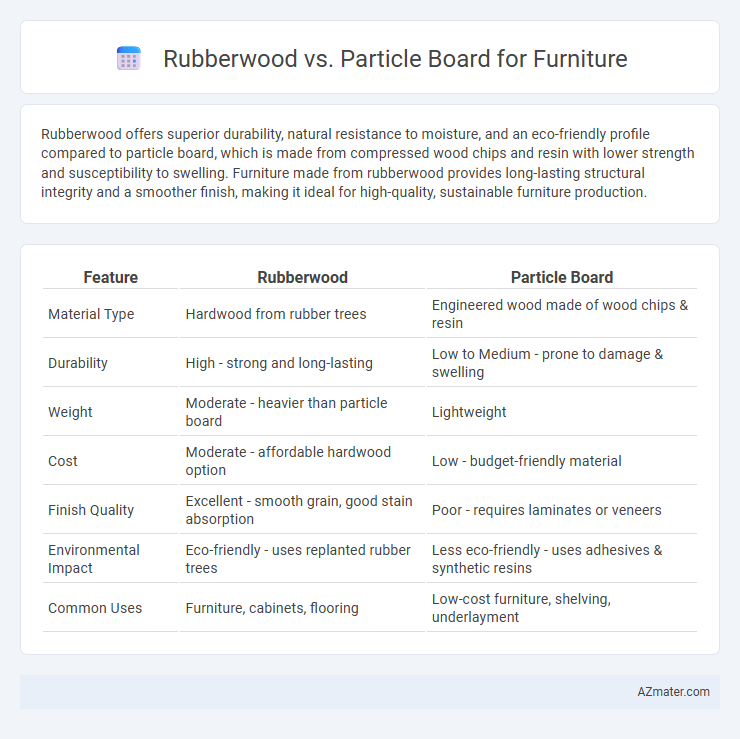Rubberwood offers superior durability, natural resistance to moisture, and an eco-friendly profile compared to particle board, which is made from compressed wood chips and resin with lower strength and susceptibility to swelling. Furniture made from rubberwood provides long-lasting structural integrity and a smoother finish, making it ideal for high-quality, sustainable furniture production.
Table of Comparison
| Feature | Rubberwood | Particle Board |
|---|---|---|
| Material Type | Hardwood from rubber trees | Engineered wood made of wood chips & resin |
| Durability | High - strong and long-lasting | Low to Medium - prone to damage & swelling |
| Weight | Moderate - heavier than particle board | Lightweight |
| Cost | Moderate - affordable hardwood option | Low - budget-friendly material |
| Finish Quality | Excellent - smooth grain, good stain absorption | Poor - requires laminates or veneers |
| Environmental Impact | Eco-friendly - uses replanted rubber trees | Less eco-friendly - uses adhesives & synthetic resins |
| Common Uses | Furniture, cabinets, flooring | Low-cost furniture, shelving, underlayment |
Introduction to Rubberwood and Particle Board
Rubberwood is a durable hardwood sourced from the Para rubber tree, commonly used in furniture manufacturing due to its strength and eco-friendly qualities. Particle board consists of wood chips, sawdust, and resin compressed into sheets, offering a cost-effective but less durable alternative for furniture construction. Both materials differ significantly in terms of density, finish quality, and moisture resistance, impacting their suitability for various furniture applications.
Material Composition and Manufacturing Process
Rubberwood furniture is crafted from the hardwood derived from the Para rubber tree (Hevea brasiliensis), known for its dense grain and durability, while particle board consists of wood chips, sawdust, and resin compressed under heat and pressure. The manufacturing process of rubberwood involves kiln drying to reduce moisture and prevent warping, ensuring strength and longevity in furniture construction. Particle board production utilizes adhesive bonding of wood particles, which creates a cost-effective but less sturdy material prone to moisture damage and lower load-bearing capacity.
Physical Properties and Appearance
Rubberwood offers superior durability and a natural grain pattern that enhances its aesthetic appeal, making it a preferred choice for high-quality furniture. Particle board, composed of compressed wood particles and resin, tends to be less durable and can absorb moisture, leading to swelling or warping, though it is often more affordable. The physical strength and rich, warm appearance of rubberwood provide long-lasting furniture with a polished finish, while particle board is typically covered with veneers or laminates to improve its look but lacks the same natural texture.
Strength and Durability Comparison
Rubberwood offers superior strength and durability compared to particle board, making it ideal for furniture exposed to daily wear and weight. Its dense grain structure provides resistance to cracking and warping, while particle board is prone to swelling and weakening when exposed to moisture. Choosing rubberwood ensures longer-lasting furniture with greater load-bearing capacity and structural integrity.
Environmental Impact and Sustainability
Rubberwood is a sustainable option for furniture due to its origin from plantation rubber trees that are harvested after latex production ends, reducing deforestation and waste. Particle board, often made from wood chips and resin, tends to incorporate recycled materials but may involve formaldehyde-based adhesives that emit volatile organic compounds (VOCs), affecting indoor air quality. Choosing rubberwood supports eco-friendly practices with biodegradable properties and lower chemical emissions compared to particle board, promoting better environmental impact in furniture production.
Cost and Affordability
Rubberwood furniture typically costs more than particle board due to its durability and natural hardwood characteristics, offering better longevity and resistance to wear. Particle board is more affordable upfront, making it a popular choice for budget-conscious buyers, but it has a shorter lifespan and is more prone to damage from moisture and heavy use. Choosing between rubberwood and particle board depends on balancing initial investment with long-term value and maintenance costs.
Suitability for Various Furniture Types
Rubberwood offers superior durability and stability, making it ideal for high-use furniture such as dining tables, chairs, and cabinets that require long-lasting strength. Particle board is cost-effective and lightweight, best suited for low-stress items like shelves, wardrobes, and temporary furnishings. The natural grain of rubberwood enhances aesthetic appeal, while particle board often requires veneers to mimic wood appearance.
Maintenance and Longevity
Rubberwood furniture offers superior durability and easier maintenance due to its dense grain, allowing for simple cleaning with mild soap and water and resistance to warping or cracking over time. Particle board, composed of compressed wood fibers and resin, tends to be less durable, often absorbing moisture and swelling, requiring careful protection from water and high humidity to maintain structural integrity. Long-term, rubberwood furniture generally outlasts particle board by several years, making it a more cost-effective and sustainable choice for durable furniture pieces.
Common Applications in Furniture Making
Rubberwood is commonly used in furniture making for crafting durable tables, chairs, and cabinets due to its strength and attractive grain. Particle board is frequently utilized for budget-friendly furniture components such as shelves, drawer bottoms, and flat-pack furniture because of its affordability and ease of manufacturing. Both materials serve distinct roles, with rubberwood favored for visible, sturdy pieces and particle board for internal or less visible parts.
Pros and Cons Overview
Rubberwood offers durability, an attractive natural grain, and eco-friendly qualities due to its sustainable sourcing from rubber trees after latex extraction, making it ideal for high-quality furniture. Particle board is cost-effective and lightweight but lacks the strength and moisture resistance of solid wood, often requiring melamine or laminate finishes to improve durability and appearance. While rubberwood provides better structural integrity and aesthetic appeal, particle board suits budget-friendly projects with less emphasis on longevity.

Infographic: Rubberwood vs Particle Board for Furniture
 azmater.com
azmater.com